Evaluating Hofstede's Cultural Dimensions in International Business
VerifiedAdded on 2021/01/01
|10
|1191
|335
Report
AI Summary
This report critically evaluates Hofstede's cultural dimensions framework, focusing on its implications for international business. It examines the four dimensions: individualism versus collectivism, power distance, uncertainty avoidance, and masculinity versus femininity, and analyzes their influence on organizational culture, communication, and management practices. The report provides a detailed analysis of how these dimensions impact various aspects of business operations, including market strategies, employee relations, and ethical considerations. It offers justifications for agreements and disagreements with the framework, providing suggestions for fostering a positive work environment and enhancing cross-cultural communication. The report concludes by summarizing the significant role of Hofstede's cultural dimensions in understanding and navigating the complexities of the global business environment. The report also includes references to support the arguments presented.

STUDY SKILLS
Paraphrase This Document
Need a fresh take? Get an instant paraphrase of this document with our AI Paraphraser
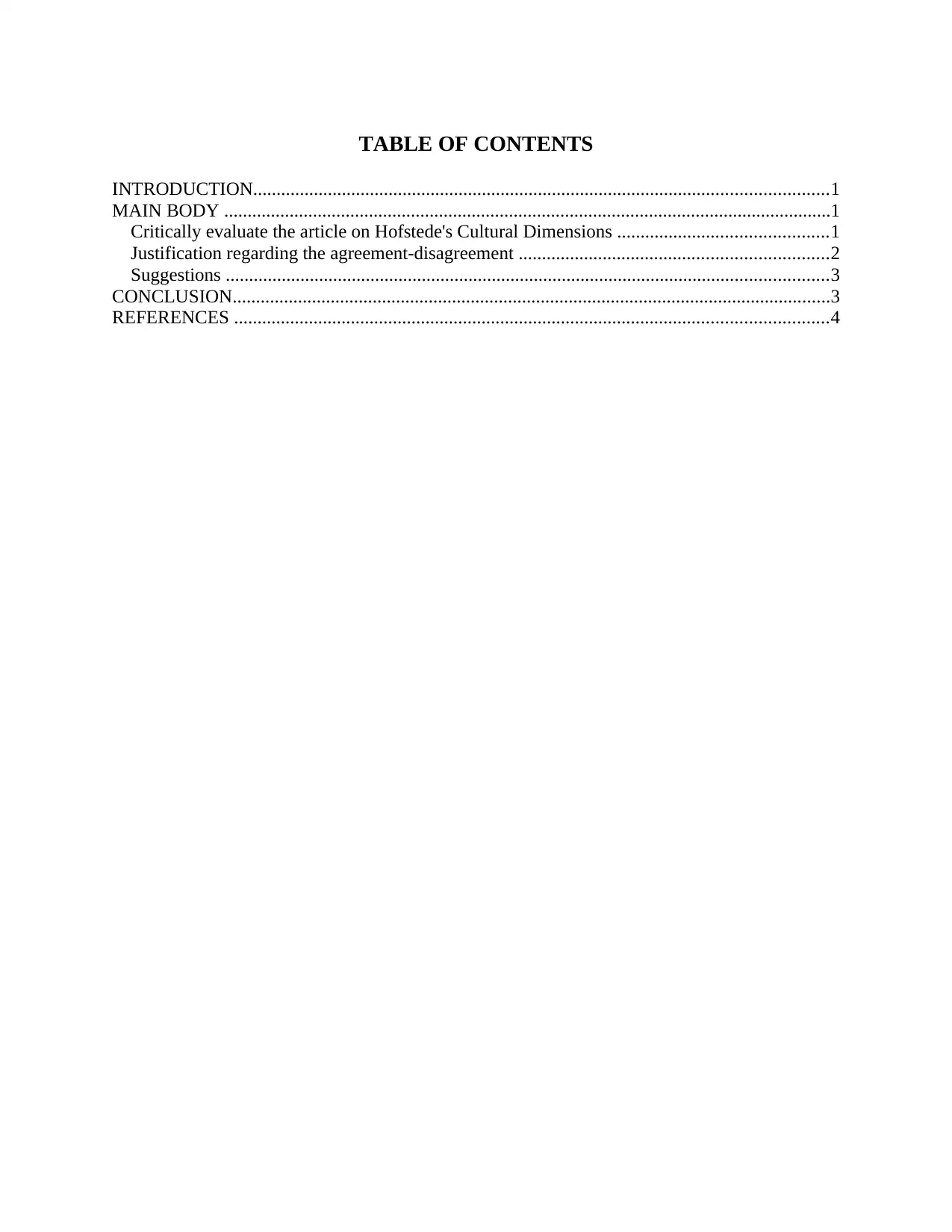
TABLE OF CONTENTS
INTRODUCTION...........................................................................................................................1
MAIN BODY ..................................................................................................................................1
Critically evaluate the article on Hofstede's Cultural Dimensions .............................................1
Justification regarding the agreement-disagreement ..................................................................2
Suggestions .................................................................................................................................3
CONCLUSION................................................................................................................................3
REFERENCES ...............................................................................................................................4
INTRODUCTION...........................................................................................................................1
MAIN BODY ..................................................................................................................................1
Critically evaluate the article on Hofstede's Cultural Dimensions .............................................1
Justification regarding the agreement-disagreement ..................................................................2
Suggestions .................................................................................................................................3
CONCLUSION................................................................................................................................3
REFERENCES ...............................................................................................................................4
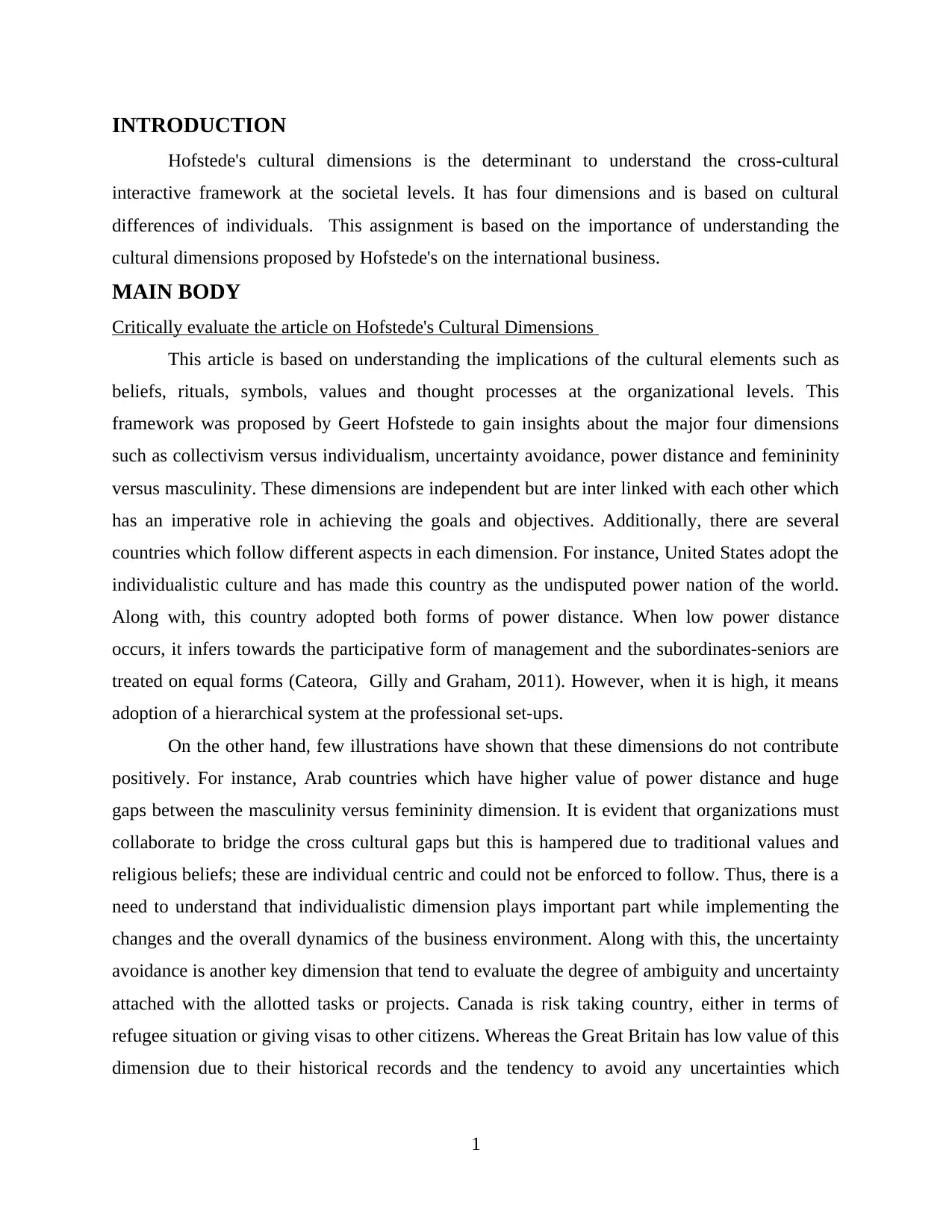
INTRODUCTION
Hofstede's cultural dimensions is the determinant to understand the cross-cultural
interactive framework at the societal levels. It has four dimensions and is based on cultural
differences of individuals. This assignment is based on the importance of understanding the
cultural dimensions proposed by Hofstede's on the international business.
MAIN BODY
Critically evaluate the article on Hofstede's Cultural Dimensions
This article is based on understanding the implications of the cultural elements such as
beliefs, rituals, symbols, values and thought processes at the organizational levels. This
framework was proposed by Geert Hofstede to gain insights about the major four dimensions
such as collectivism versus individualism, uncertainty avoidance, power distance and femininity
versus masculinity. These dimensions are independent but are inter linked with each other which
has an imperative role in achieving the goals and objectives. Additionally, there are several
countries which follow different aspects in each dimension. For instance, United States adopt the
individualistic culture and has made this country as the undisputed power nation of the world.
Along with, this country adopted both forms of power distance. When low power distance
occurs, it infers towards the participative form of management and the subordinates-seniors are
treated on equal forms (Cateora, Gilly and Graham, 2011). However, when it is high, it means
adoption of a hierarchical system at the professional set-ups.
On the other hand, few illustrations have shown that these dimensions do not contribute
positively. For instance, Arab countries which have higher value of power distance and huge
gaps between the masculinity versus femininity dimension. It is evident that organizations must
collaborate to bridge the cross cultural gaps but this is hampered due to traditional values and
religious beliefs; these are individual centric and could not be enforced to follow. Thus, there is a
need to understand that individualistic dimension plays important part while implementing the
changes and the overall dynamics of the business environment. Along with this, the uncertainty
avoidance is another key dimension that tend to evaluate the degree of ambiguity and uncertainty
attached with the allotted tasks or projects. Canada is risk taking country, either in terms of
refugee situation or giving visas to other citizens. Whereas the Great Britain has low value of this
dimension due to their historical records and the tendency to avoid any uncertainties which
1
Hofstede's cultural dimensions is the determinant to understand the cross-cultural
interactive framework at the societal levels. It has four dimensions and is based on cultural
differences of individuals. This assignment is based on the importance of understanding the
cultural dimensions proposed by Hofstede's on the international business.
MAIN BODY
Critically evaluate the article on Hofstede's Cultural Dimensions
This article is based on understanding the implications of the cultural elements such as
beliefs, rituals, symbols, values and thought processes at the organizational levels. This
framework was proposed by Geert Hofstede to gain insights about the major four dimensions
such as collectivism versus individualism, uncertainty avoidance, power distance and femininity
versus masculinity. These dimensions are independent but are inter linked with each other which
has an imperative role in achieving the goals and objectives. Additionally, there are several
countries which follow different aspects in each dimension. For instance, United States adopt the
individualistic culture and has made this country as the undisputed power nation of the world.
Along with, this country adopted both forms of power distance. When low power distance
occurs, it infers towards the participative form of management and the subordinates-seniors are
treated on equal forms (Cateora, Gilly and Graham, 2011). However, when it is high, it means
adoption of a hierarchical system at the professional set-ups.
On the other hand, few illustrations have shown that these dimensions do not contribute
positively. For instance, Arab countries which have higher value of power distance and huge
gaps between the masculinity versus femininity dimension. It is evident that organizations must
collaborate to bridge the cross cultural gaps but this is hampered due to traditional values and
religious beliefs; these are individual centric and could not be enforced to follow. Thus, there is a
need to understand that individualistic dimension plays important part while implementing the
changes and the overall dynamics of the business environment. Along with this, the uncertainty
avoidance is another key dimension that tend to evaluate the degree of ambiguity and uncertainty
attached with the allotted tasks or projects. Canada is risk taking country, either in terms of
refugee situation or giving visas to other citizens. Whereas the Great Britain has low value of this
dimension due to their historical records and the tendency to avoid any uncertainties which
1
⊘ This is a preview!⊘
Do you want full access?
Subscribe today to unlock all pages.

Trusted by 1+ million students worldwide
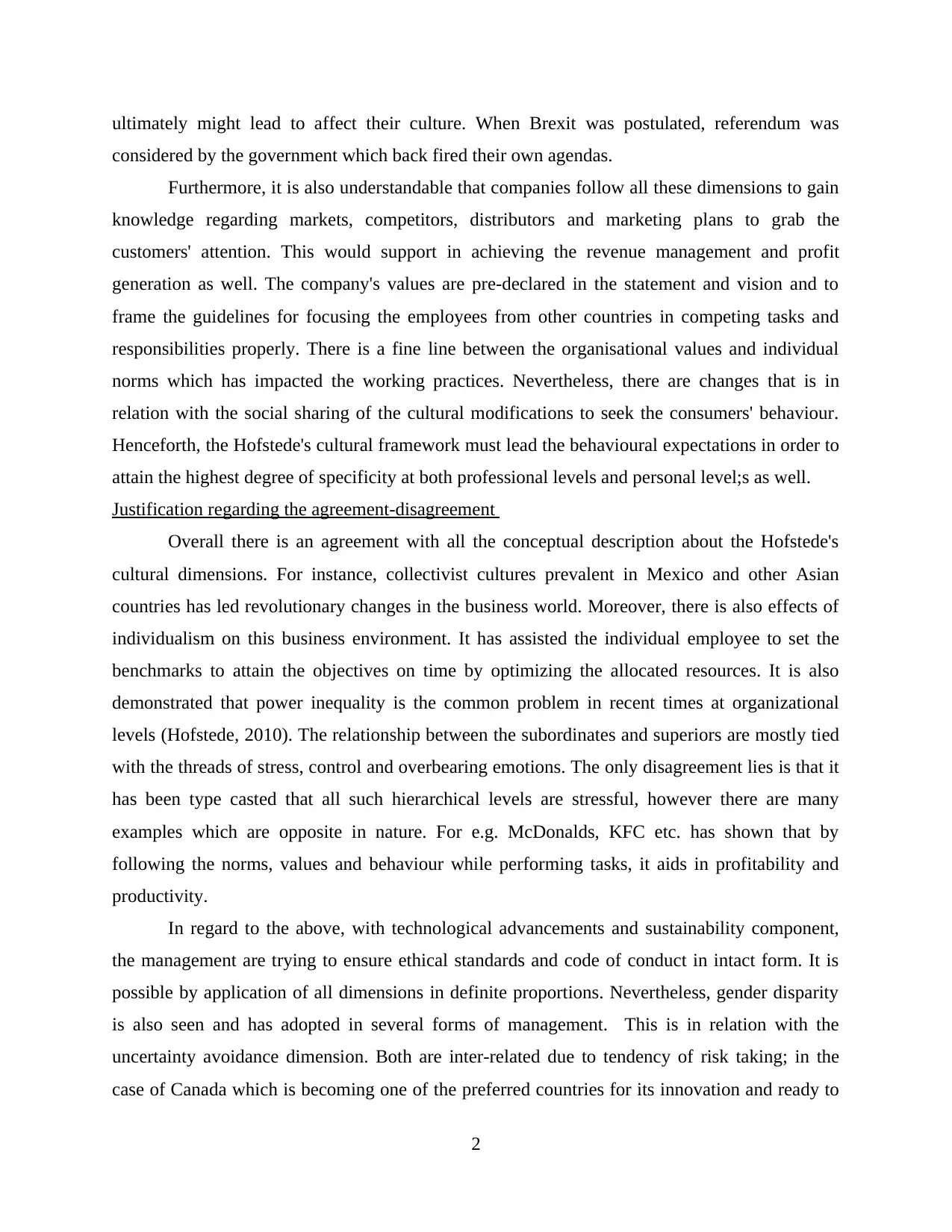
ultimately might lead to affect their culture. When Brexit was postulated, referendum was
considered by the government which back fired their own agendas.
Furthermore, it is also understandable that companies follow all these dimensions to gain
knowledge regarding markets, competitors, distributors and marketing plans to grab the
customers' attention. This would support in achieving the revenue management and profit
generation as well. The company's values are pre-declared in the statement and vision and to
frame the guidelines for focusing the employees from other countries in competing tasks and
responsibilities properly. There is a fine line between the organisational values and individual
norms which has impacted the working practices. Nevertheless, there are changes that is in
relation with the social sharing of the cultural modifications to seek the consumers' behaviour.
Henceforth, the Hofstede's cultural framework must lead the behavioural expectations in order to
attain the highest degree of specificity at both professional levels and personal level;s as well.
Justification regarding the agreement-disagreement
Overall there is an agreement with all the conceptual description about the Hofstede's
cultural dimensions. For instance, collectivist cultures prevalent in Mexico and other Asian
countries has led revolutionary changes in the business world. Moreover, there is also effects of
individualism on this business environment. It has assisted the individual employee to set the
benchmarks to attain the objectives on time by optimizing the allocated resources. It is also
demonstrated that power inequality is the common problem in recent times at organizational
levels (Hofstede, 2010). The relationship between the subordinates and superiors are mostly tied
with the threads of stress, control and overbearing emotions. The only disagreement lies is that it
has been type casted that all such hierarchical levels are stressful, however there are many
examples which are opposite in nature. For e.g. McDonalds, KFC etc. has shown that by
following the norms, values and behaviour while performing tasks, it aids in profitability and
productivity.
In regard to the above, with technological advancements and sustainability component,
the management are trying to ensure ethical standards and code of conduct in intact form. It is
possible by application of all dimensions in definite proportions. Nevertheless, gender disparity
is also seen and has adopted in several forms of management. This is in relation with the
uncertainty avoidance dimension. Both are inter-related due to tendency of risk taking; in the
case of Canada which is becoming one of the preferred countries for its innovation and ready to
2
considered by the government which back fired their own agendas.
Furthermore, it is also understandable that companies follow all these dimensions to gain
knowledge regarding markets, competitors, distributors and marketing plans to grab the
customers' attention. This would support in achieving the revenue management and profit
generation as well. The company's values are pre-declared in the statement and vision and to
frame the guidelines for focusing the employees from other countries in competing tasks and
responsibilities properly. There is a fine line between the organisational values and individual
norms which has impacted the working practices. Nevertheless, there are changes that is in
relation with the social sharing of the cultural modifications to seek the consumers' behaviour.
Henceforth, the Hofstede's cultural framework must lead the behavioural expectations in order to
attain the highest degree of specificity at both professional levels and personal level;s as well.
Justification regarding the agreement-disagreement
Overall there is an agreement with all the conceptual description about the Hofstede's
cultural dimensions. For instance, collectivist cultures prevalent in Mexico and other Asian
countries has led revolutionary changes in the business world. Moreover, there is also effects of
individualism on this business environment. It has assisted the individual employee to set the
benchmarks to attain the objectives on time by optimizing the allocated resources. It is also
demonstrated that power inequality is the common problem in recent times at organizational
levels (Hofstede, 2010). The relationship between the subordinates and superiors are mostly tied
with the threads of stress, control and overbearing emotions. The only disagreement lies is that it
has been type casted that all such hierarchical levels are stressful, however there are many
examples which are opposite in nature. For e.g. McDonalds, KFC etc. has shown that by
following the norms, values and behaviour while performing tasks, it aids in profitability and
productivity.
In regard to the above, with technological advancements and sustainability component,
the management are trying to ensure ethical standards and code of conduct in intact form. It is
possible by application of all dimensions in definite proportions. Nevertheless, gender disparity
is also seen and has adopted in several forms of management. This is in relation with the
uncertainty avoidance dimension. Both are inter-related due to tendency of risk taking; in the
case of Canada which is becoming one of the preferred countries for its innovation and ready to
2
Paraphrase This Document
Need a fresh take? Get an instant paraphrase of this document with our AI Paraphraser
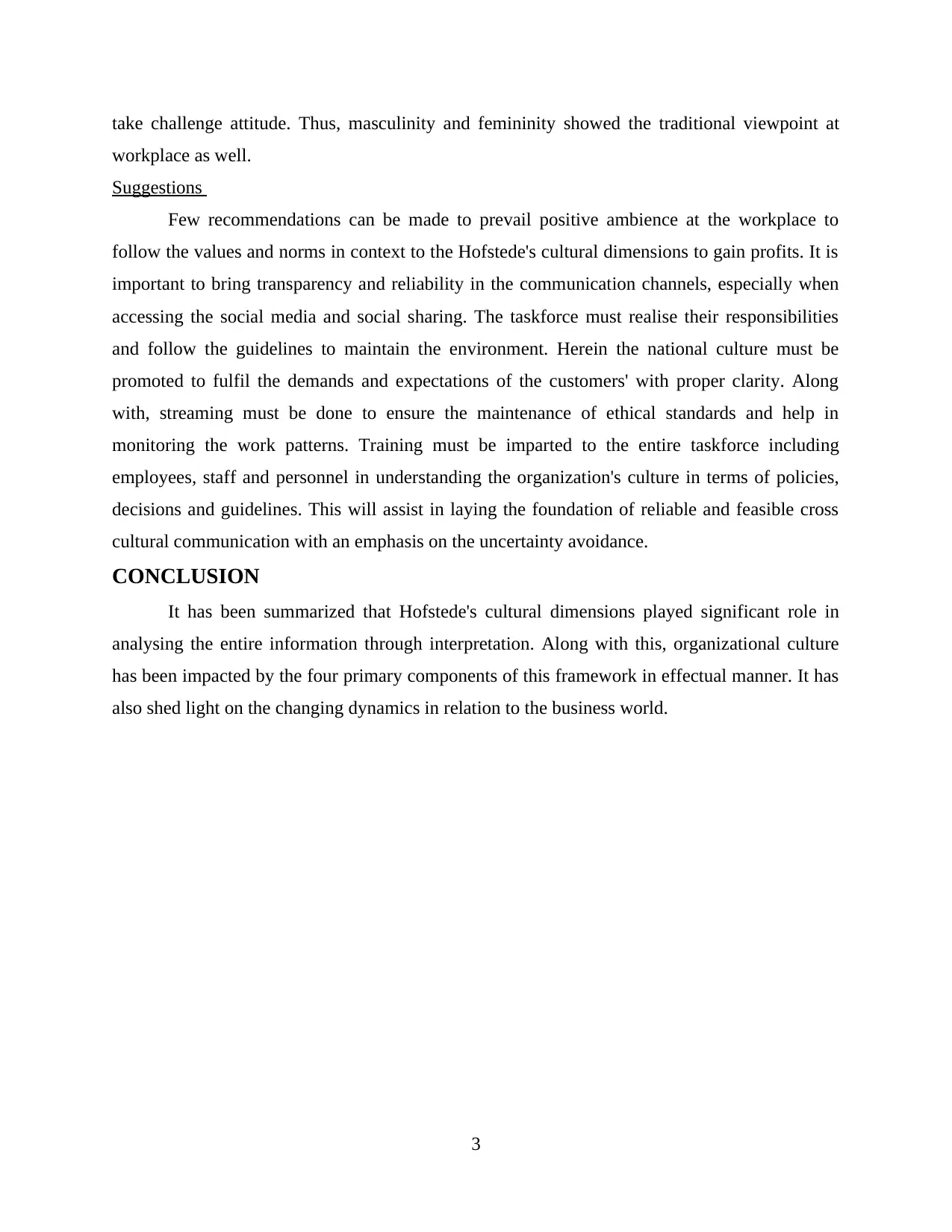
take challenge attitude. Thus, masculinity and femininity showed the traditional viewpoint at
workplace as well.
Suggestions
Few recommendations can be made to prevail positive ambience at the workplace to
follow the values and norms in context to the Hofstede's cultural dimensions to gain profits. It is
important to bring transparency and reliability in the communication channels, especially when
accessing the social media and social sharing. The taskforce must realise their responsibilities
and follow the guidelines to maintain the environment. Herein the national culture must be
promoted to fulfil the demands and expectations of the customers' with proper clarity. Along
with, streaming must be done to ensure the maintenance of ethical standards and help in
monitoring the work patterns. Training must be imparted to the entire taskforce including
employees, staff and personnel in understanding the organization's culture in terms of policies,
decisions and guidelines. This will assist in laying the foundation of reliable and feasible cross
cultural communication with an emphasis on the uncertainty avoidance.
CONCLUSION
It has been summarized that Hofstede's cultural dimensions played significant role in
analysing the entire information through interpretation. Along with this, organizational culture
has been impacted by the four primary components of this framework in effectual manner. It has
also shed light on the changing dynamics in relation to the business world.
3
workplace as well.
Suggestions
Few recommendations can be made to prevail positive ambience at the workplace to
follow the values and norms in context to the Hofstede's cultural dimensions to gain profits. It is
important to bring transparency and reliability in the communication channels, especially when
accessing the social media and social sharing. The taskforce must realise their responsibilities
and follow the guidelines to maintain the environment. Herein the national culture must be
promoted to fulfil the demands and expectations of the customers' with proper clarity. Along
with, streaming must be done to ensure the maintenance of ethical standards and help in
monitoring the work patterns. Training must be imparted to the entire taskforce including
employees, staff and personnel in understanding the organization's culture in terms of policies,
decisions and guidelines. This will assist in laying the foundation of reliable and feasible cross
cultural communication with an emphasis on the uncertainty avoidance.
CONCLUSION
It has been summarized that Hofstede's cultural dimensions played significant role in
analysing the entire information through interpretation. Along with this, organizational culture
has been impacted by the four primary components of this framework in effectual manner. It has
also shed light on the changing dynamics in relation to the business world.
3
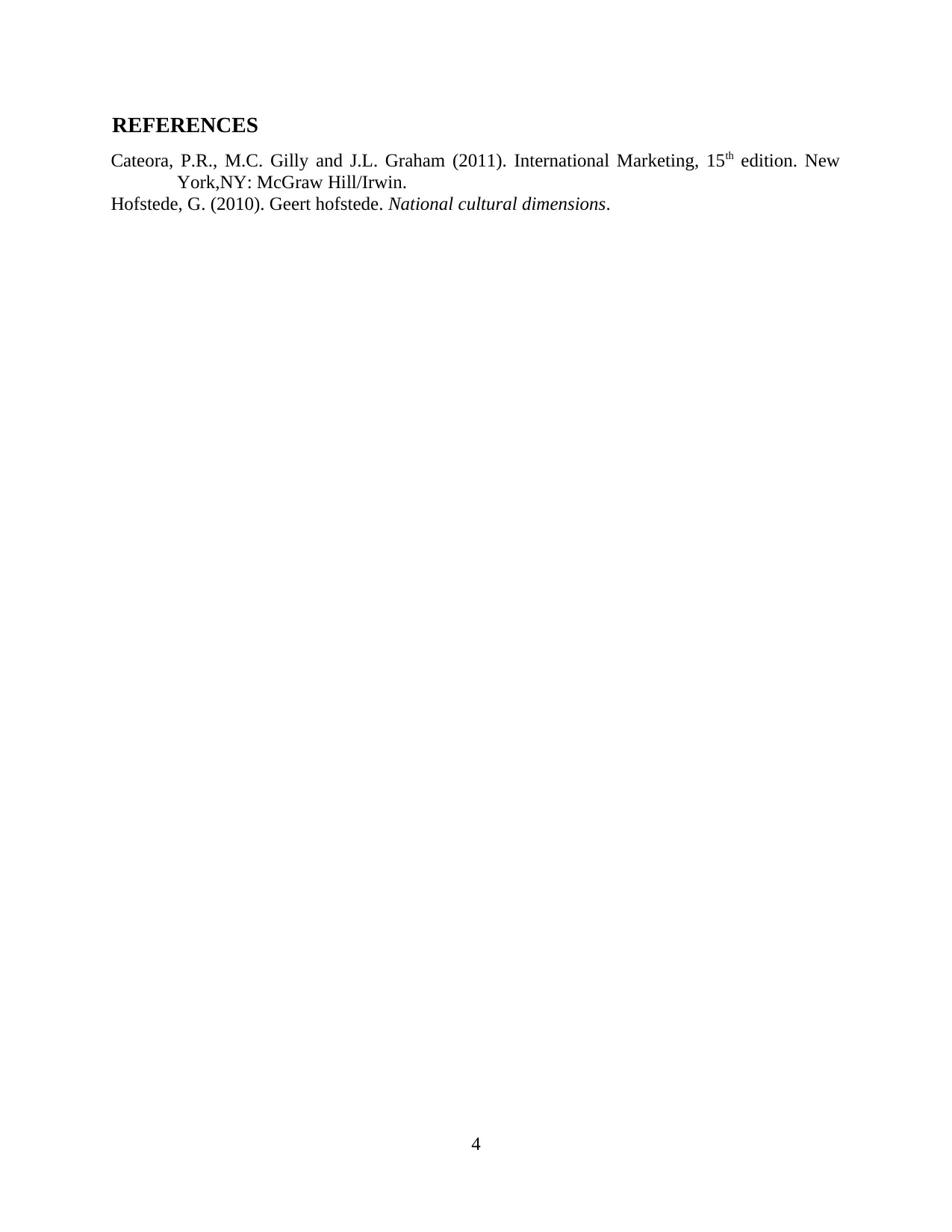
REFERENCES
Cateora, P.R., M.C. Gilly and J.L. Graham (2011). International Marketing, 15th edition. New
York,NY: McGraw Hill/Irwin.
Hofstede, G. (2010). Geert hofstede. National cultural dimensions.
4
Cateora, P.R., M.C. Gilly and J.L. Graham (2011). International Marketing, 15th edition. New
York,NY: McGraw Hill/Irwin.
Hofstede, G. (2010). Geert hofstede. National cultural dimensions.
4
⊘ This is a preview!⊘
Do you want full access?
Subscribe today to unlock all pages.

Trusted by 1+ million students worldwide

5
Paraphrase This Document
Need a fresh take? Get an instant paraphrase of this document with our AI Paraphraser

6

7
⊘ This is a preview!⊘
Do you want full access?
Subscribe today to unlock all pages.

Trusted by 1+ million students worldwide

8
1 out of 10
Related Documents
Your All-in-One AI-Powered Toolkit for Academic Success.
+13062052269
info@desklib.com
Available 24*7 on WhatsApp / Email
![[object Object]](/_next/static/media/star-bottom.7253800d.svg)
Unlock your academic potential
Copyright © 2020–2025 A2Z Services. All Rights Reserved. Developed and managed by ZUCOL.




